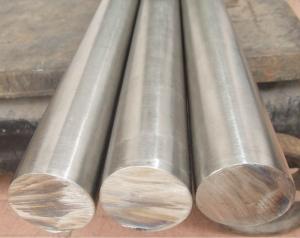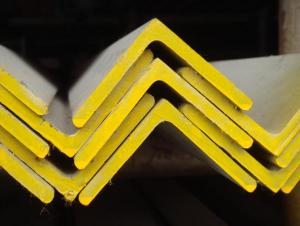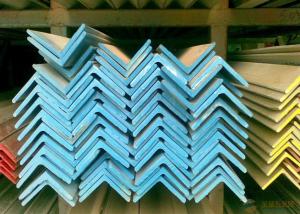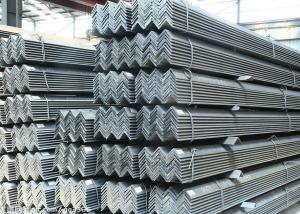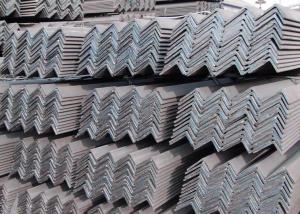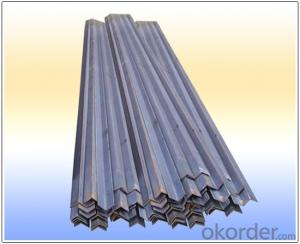Stainless steel angle; angle steel
- Loading Port:
- Guangzhou
- Payment Terms:
- TT OR LC
- Min Order Qty:
- 50 m.t.
- Supply Capability:
- 10000 m.t./month
OKorder Service Pledge
OKorder Financial Service
You Might Also Like
General Informaiton of Stainless Steel Angle Bar
1. Grade: SS200, 300,400 series
2. Size: 25×25×3 mm-100×100×10mm
3. Process: HRAP
4. Length: 2-6m
5. Shape: Equal
6. Delivery: within 20 days
7. MOQ: 1 ton
8. Certificate: ISO 9001:2008, SGS
9. Package: Standard Export Packing, or put into wooden boxes according to your requirement
10. Application: Construction, Marine, Industry etc.
Specification of Stainless Steel Angle Bar
Name | Stainless Steel Angles | |||||
Standard | ASTM A554, A312, A249, A269 and A270 | |||||
Material Grade | 304,316,201,202, 316L,430 | |||||
Length | 6m or as customers' request | |||||
Tolerance | a) Thickness: +/-0. 15mm | |||||
b) Length: +/-4. 5mm - 0mm | ||||||
Surface | 180G, 320G, 400G Satin / Hairline(Matt Finish, Brush, Dull Finish) 400G, 500G, 600G or 800G Mirror finish | |||||
Application | Decoration construction, upholstery, industry instruments | |||||
Test | Squash test, Extended test, Water pressure test, Crystal rot test, Heat treatment, NDT | |||||
Chemical Composition of Material | Composition Material | 201 | 202 | 304 | 316 | 430 |
C | ≤0.15 | ≤0.15 | ≤0.08 | ≤0.08 | ≤0.12 | |
Si | ≤1.00 | ≤1.00 | ≤1.00 | ≤1.00 | ≤1.00 | |
Mn | 5.5-7.5 | 7.5-10 | ≤2.00 | ≤2.00 | ≤1.00 | |
P | ≤0.06 | ≤0.06 | ≤0.045 | ≤0.045 | ≤0.040 | |
S | ≤0.03 | ≤0.03 | ≤0.030 | ≤0.030 | ≤0.030 | |
Cr | 16-18 | 17-19 | 18-20 | 16-18 | 16-18 | |
Ni | 3.5-5.5 | 4-6 | 8-10.5 | 10-14 | ||
Mo | 2.0-3.0 | |||||
Mechanical Property | Material Item | 201 | 202 | 304 | 316 | |
Tensile Strength | ≥535 | ≥520 | ≥520 | ≥520 | ||
Yield Strength | ≥245 | ≥205 | ≥205 | ≥205 | ||
Extension | ≥30% | ≥30% | ≥35% | ≥35% | ||
Hardness (HV) | <253 | <253 | <200 | <200 | ||
- Q:Can stainless steel angle be used in structural applications?
- Yes, stainless steel angle can be used in structural applications. Stainless steel is known for its strength, durability, and resistance to corrosion, making it suitable for various structural applications. Stainless steel angle is often used to provide structural support, reinforcement, and stability in buildings, bridges, and other infrastructure projects. It can be used in load-bearing applications where strength and stability are crucial. Additionally, stainless steel angle is available in different sizes, grades, and finishes, allowing for versatility and customization to meet specific structural requirements.
- Q:Can stainless steel angles be used outdoors?
- Yes, stainless steel angles can be used outdoors. Stainless steel is highly resistant to corrosion, making it a suitable material for outdoor applications where it may be exposed to moisture, humidity, and other environmental elements.
- Q:Are stainless steel angles suitable for balconies and railings?
- Yes, stainless steel angles are highly suitable for balconies and railings. Stainless steel is known for its strength, durability, and corrosion resistance, making it an excellent choice for outdoor applications. Stainless steel angles provide structural support and can withstand harsh weather conditions, ensuring the safety and longevity of balconies and railings.
- Q:Can stainless steel angles be used in the construction of handrails?
- Indeed, the utilization of stainless steel angles is possible in the construction of handrails. The enduring nature, resistance to corrosion, and pleasing visual qualities of stainless steel render it a favored option for handrails. The malleability of stainless steel angles allows for effortless customization to achieve the desired dimensions and contour for handrails. Furthermore, they offer structural reinforcement and stability, rendering them suitable for employment in both interior and exterior scenarios. Moreover, the maintenance and cleanliness of stainless steel angles are easily manageable, guaranteeing the handrail's longevity.
- Q:What is the weight calculation formula for stainless steel angles?
- To calculate the weight of a stainless steel angle, you can use the following formula: Multiply the density of stainless steel by the cross-sectional area of the angle. The density of stainless steel is typically 7.9 g/cm³ or 7900 kg/m³. To find the cross-sectional area of the angle, multiply the thickness of the stainless steel angle by the sum of its width and height. These measurements are usually in millimeters (mm). Hence, the weight (W) of a stainless steel angle can be determined using the equation: W = (Density) x (Thickness) x (Width + Height) Where W represents the weight of the angle in kilograms (kg).
- Q:Are stainless steel angles available in custom sizes?
- Yes, stainless steel angles are available in custom sizes. Stainless steel angles are commonly used in construction, engineering, and industrial applications, and they can be manufactured to specific dimensions to meet the unique requirements of a project. Custom sizes can be achieved by working with a steel supplier or manufacturer who can provide fabrication services to cut and shape the stainless steel angles according to the desired specifications. This allows for greater flexibility and ensures that the angles are tailored to fit the specific needs of a project.
- Q:How do you calculate the load-bearing capacity of stainless steel angles?
- The load-bearing capacity of stainless steel angles can be determined by taking into account multiple factors, including the angle's dimensions, the material properties of the stainless steel, and the applied load. One way to calculate the load-bearing capacity is by utilizing Euler's formula for column buckling, which considers the angle's length, moment of inertia, and modulus of elasticity to determine the critical buckling load. Another approach involves calculating the maximum bending moment that the angle can withstand before reaching its yield strength. This can be determined by considering the section modulus of the angle and the applied load. It is important to note that these calculations are based on assumptions and simplifications. The actual load-bearing capacity may be influenced by additional factors, such as the quality of fabrication, surface conditions, and the presence of other loads or stresses. For an accurate determination of the load-bearing capacity of stainless steel angles, it is advisable to consult engineering handbooks, industry standards, or seek guidance from a structural engineer who can analyze all relevant factors and provide a precise analysis.
- Q:How do you prevent distortion when welding stainless steel angles?
- To prevent distortion when welding stainless steel angles, there are several key measures that can be taken: 1. Proper fit-up: Ensuring that the joint between the angles is properly aligned and tightly fit together is crucial. Any gaps or misalignment can lead to distortion during the welding process. It is recommended to use clamps or fixtures to hold the angles in place before welding. 2. Adequate tack welding: Before fully welding the angles, it is important to make temporary tack welds at regular intervals along the joint. Tack welding helps to stabilize the workpiece and reduces the chances of distortion by distributing the heat evenly. 3. Controlled heat input: Stainless steel has a lower thermal conductivity compared to other metals, so it is essential to control the heat input during welding. Excessive heat can cause the material to expand and contract, leading to distortion. Employing a welding technique that provides a balanced heat input, such as TIG (Tungsten Inert Gas) welding, can help minimize distortion. 4. Proper welding sequence: The welding sequence can also affect distortion. Starting welding from the center and moving towards the ends can help distribute the heat evenly and reduce potential distortion. Additionally, alternating between the two sides of the joint can help balance the thermal effects. 5. Preheating and post-weld heat treatment: Preheating the stainless steel angles before welding can help reduce the temperature gradient between the joint and the surrounding material, minimizing distortion. Similarly, post-weld heat treatment, such as stress relieving, can help relieve residual stresses and further reduce distortion. 6. Welding fixtures and jigs: Using welding fixtures and jigs can provide additional support and control during welding. These tools can help maintain the proper alignment of the angles and reduce the chances of distortion. 7. Proper welding technique and parameters: Choosing the right welding technique and parameters is crucial. For stainless steel angles, TIG welding is often preferred due to its precise control of heat input. Additionally, adjusting the welding parameters, such as the welding speed, current, and shielding gas flow, can help minimize distortion. By following these preventive measures, welders can significantly reduce the risk of distortion when welding stainless steel angles, ensuring a high-quality and structurally sound final product.
- Q:Can stainless steel angles be used in the construction industry?
- Yes, stainless steel angles can be used in the construction industry. They are commonly used for providing structural support, as well as for framing, bracing, and reinforcing various structures such as buildings, bridges, and machinery. Stainless steel angles offer excellent strength, durability, and corrosion resistance, making them a suitable choice for construction applications where resistance to environmental factors is essential.
- Q:Can stainless steel angles be used for elevator shafts?
- Indeed, elevator shafts can incorporate stainless steel angles. Renowned for their robustness, longevity, and immunity to corrosion, stainless steel angles prove to be an ideal selection for elevator shafts. Given that elevator shafts necessitate materials capable of enduring substantial burdens and continuous usage over an extended duration, stainless steel angles offer the essential structural reinforcement and can withstand the weight and strain associated with elevator operation. Furthermore, the fire-resistant properties of stainless steel angles merit significant attention as a vital safety concern for elevator shafts. Ultimately, stainless steel angles emerge as a dependable and pragmatic choice for the construction of elevator shafts.
1. Manufacturer Overview |
|
|---|---|
| Location | |
| Year Established | |
| Annual Output Value | |
| Main Markets | |
| Company Certifications | |
2. Manufacturer Certificates |
|
|---|---|
| a) Certification Name | |
| Range | |
| Reference | |
| Validity Period | |
3. Manufacturer Capability |
|
|---|---|
| a)Trade Capacity | |
| Nearest Port | |
| Export Percentage | |
| No.of Employees in Trade Department | |
| Language Spoken: | |
| b)Factory Information | |
| Factory Size: | |
| No. of Production Lines | |
| Contract Manufacturing | |
| Product Price Range | |
Send your message to us
Stainless steel angle; angle steel
- Loading Port:
- Guangzhou
- Payment Terms:
- TT OR LC
- Min Order Qty:
- 50 m.t.
- Supply Capability:
- 10000 m.t./month
OKorder Service Pledge
OKorder Financial Service
Similar products
New products
Hot products
Hot Searches
Related keywords






